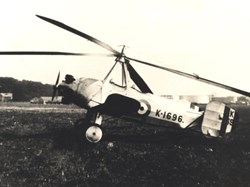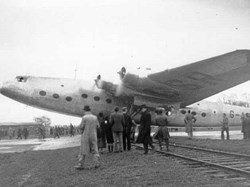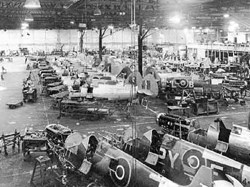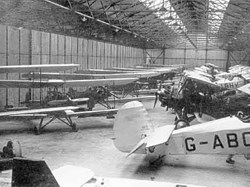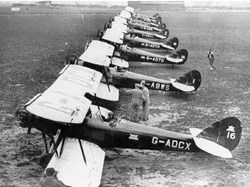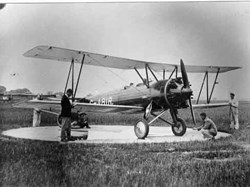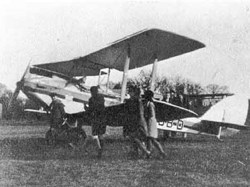Hamble's Airfields
Although Hamble has long been associated with aviation, it is not generally known that there were two airfields, one to the north and the other south of Hamble Lane. This article has been written from notes prepared by Tony Sedgwick, who spoke to the History Society about the sites in April 2000.
HAMBLE'S AIRFIELDS
South: In 1916, A V Roe purchased land in Hamble for the establishment of an aircraft factory, and what became known as the South airfield. This area was bounded by Hamble Lane, Southampton Water, the gully presently behind Westfield Close, and the railway line running into what was the Admiralty Acceptance Depot, which is now part of the BP complex. The factory building had a distinctive square tower, with a model airship on top which was used as a wind sock. The site slopes steeply down to Southampton Water, as can be seen by looking along Ensign Way. Land was also purchased in 1916 for the building of 24 houses for employees, in what is now Verdon Avenue. Production and test flying started late in 1917, building the successful AVRO 504, and continued until early 1919.
Main production was then moved to Manchester and, on a very much reduced staff, Hamble became an experimental aircraft department. The airfield was becoming unsuitable for some aircraft so, in 1926, land was purchased to the north of Verdon Avenue, extending to the Portsmouth - Southampton railway line. This site became known as the North airfield.
To use this facility aircraft were either taxied or towed from the factory, crossing Hamble Lane by the present BP entrance, and following the railway line to the airfield. Large aircraft in Hamble Lane provided an awesome sight, particularly when one became 'stuck'. This practice continued until about 1950, after the Berlin Airlift, when aircraft were no longer dealt with in the old AVRO factory.
By 1932 the factory was mainly on a 'care and maintenance' system, and had become the responsibility of Air Service Training Ltd (AST.) It accommodated AST's amphibians and floatplanes, which used the slipway onto Southampton Water. The site was also used for test flying Cierva autogiros, and assembly of some AVRO aircraft such as Tutors for AST's use. Floatplanes, built in Manchester for the RAF at Calshot, also used the facility. Towards the end of 1933, all flying ceased from the South airfield. Some of the land was purchased by Shell Mex and BP, who also bought more after the war.
In 1934 two large extensions to the factory were built for the production of a new airliner, the Armstrong Whitworth Ensign, a four engined aircraft with a wingspan of 123 feet. The first flew on January 24th 1938, and production continued until 28th October 1941, when 14 had been built. Some of these returned to Hamble in the 1940's to be fitted with more powerful engines. Article about the 'Ensign'.
On 20th March 1940 the prototype twin-engined bomber, the A.W Albemarle built in the old AVRO factory, flew for the first time from the North airfield. During the war years Spitfires were repaired at the factory, whilst several other types were modified including Hampdens, Lancasters, Flying Fortress Mitchells, Mustangs, Mosquitoes and Yorks.
In January 1943, a Flying Fortress taxiing under it's own power, became stuck in the mud after crossing Hamble Lane, blocking the road. It was an embarrassing situation, because the aircraft had just been fitted with secret submarine-detecting equipment, which looked like small telegraph poles beneath the wings.
During the early 1950's, more workshops and stores were added behind the original factory, whilst a new toolroom and machine shop were added at the front, to cater for the production of assemblies for Meteor and, later, Javelin aircraft. Most aircraft work ceased in 1959, and the factory became part of the Petter organisation. The slipway was used by Aquila Airways beween 1949 and 1958, for the overhaul of their flying boats. The small hangar built for them was still in existence in April 2000.
North: As mentioned earlier, the North airfield was opened in 1926. Early users apart from AVRO, were Fairey Aviation, Simmonds Aircraft (who built aircraft at the Rolling Mills, Weston,) Vickers/Supermarine of Woolston, and the Resident Hampshire Aeroplane Club. The existing facilities built for the Admiralty Acceptance Depot, were used as workshops etc, the entrance to the site being approximately where Aquila Way is today.
On Sunday 15th May 1927, the Hampshire Air Pageant was held at Hamble, with many new types being on show. A cover of a surviving programme shows that the South airfield was used for joyriding, while the North airfield was classed as the Pageant Aerodrome, something that the Civil Aviation Authority would not countenance today, especially since there was an 'air race' in the programme! The '5 shilling' enclosure was along the north side of the BP railway line, the '2/6d' behind Hampton Cottages, and the 'shilling' enclosure was to the north, alongside the Southern Railway cutting. (Video of Air Pageant)
In January 1931, the Armstrong Whitworth Aircraft Reserve School moved to Hamble from Whitley, near Coventry, and became Air Service Training Ltd. A hangar was built at the eastern end of Verdon Avenue, the entrance being in Sydney Avenue. This building became 'B' Hangar, circa 1939. The school opened on 14th April 1931, the first aircraft fleet consisting of an AVRO 504, three DH 9J's, two AWA Siskins, three AWA Atlas Trainers, and two AVRO Tutors. One of the Siskins only lasted until 8th June 1931, when it was involved in a fatal accident at Sarisbury Green.
The following is a list of events recorded in the AST diary:-
May1931 - Most of the old Admiralty Barracks modified for classrooms.
22nd August 1932 - Amy Johnson joined for a blind-flying course. She was not the first lady pupil, that being the Hon Mrs Victor Bruce in October 1931.
October 1932 - The Hampshire Aeroplane Club left for Eastleigh.
31st December 1933 - The training fleet had grown to 26 aircraft which included 9 AVRO Cadets, 2 Cutty Sark Amphibians, and one AVRO 5 (G-ABBY.)
1st October 1934 - The whole AVRO estate in Hamble, including 24 houses in Verdon Avenue, was transferred to Air Service Training.
31st December 1935 - There were 35 aircraft on charge, whilst another hangar (C) next to the main hangar, was completed during March 1936.
April 1937 - The original hangar was extended by another two bays.
December 1937 - The Royal Air Force Reserve, which hitherto had a couple of aircraft based at Hamble, became No.3 Elementary and Reserve Flying Training School (the 'Reserve' was dropped on the outbreak of war) and received a number of new 'Modern' aircraft. Thus on 31st December, the AST fleet consisted of 37 aircraft, and the No.3 ERFTS had 14.
June 1939 - A new large hangar (A) was completed. This was later to become part of the Glover Webb industrial site, and was demolished in the late 1990's for the building of Spitfire Way. It was mainly intended for No.3 ERFTS, which had rapidly expanded and even included some Fairey Battles - although it has been said that they were never used at Hamble.
September 1939 - All AST aircraft lost their black fuselage/silver wing colours, and were camouflaged with yellow undersides. Whilst the single-engined aircraft came under the wing of No.3 ERFTS, the multi-engined types became part of No.11 Air Observers Navigation School, and No.1 Supplementary Wireless School. Later in the month a contract was signed with the Air Ministry for repairs to Spitfires, the first being on 5th October 1939.
12th July 1940 - At noon, 4 bombs were dropped on Hamble. Three fell in fields in School Lane, and one in the garden of 'Myrtles.'
20th July 1940 - All three flying schools left Hamble, No.3 ERFTS and 11 AONS moving to Watchfield, and No.1 Supplementary Wireless School being disbanded. The airfield was now used only by aircraft undergoing repair, and a detachment of Blackburn Sharks from HMS Raven at Eastleigh, which arrived earlier in the year.
23rd November 1940 - During a heavy raid on Southampton, a number of incendiary bombs fell onto the airfield, just after 6 pm. A week later, parachute flares were seen descending onto the airfield.
28th December 1940 - A Handley Page bomber recently repaired at AST, took off on an air test and crashed into Shell Mex and BP. The pilot, Fl.Lt. Pegg was slightly hurt.
9th January 1941 - Nine aircraft attacked Southampton, 3 attacked Portsmouth, and over 200 attacked Manchester. A large bomb was dropped in the middle of Hamble airfield but, like the earlier incendiaries and flares, it caused no damage to buildings.
5th April 1941 - Bofor AA guns were positioned around Hamble, on the shores of Southampton Water, the airfield and round Satchell Lane.
11th April 1941 - Four parachute mines fell in the area during a raid on Southampton. One, which fortunately did not explode, landed among the storage tanks at Shell Mex.
14th June 1941 - Another hangar (F) was completed at Badnam Copse. 'Wessex Manor' now stands on the site.
30th August 1941 - Follands/Fairey had a flight hangar built at the west end of Verdon Avenue. It is still there, much modified, on the industrial estate.
20th September 1941 - Air Transport Auxiliary Female Pilots Pool established in new hangar, south of Hampton Cottages.
5th November 1941 - Part of Fleet Air Arm Squadron 780 arrived from Lee-on-Solent for training. They used canvas hangars situated above Hampton Houses and the Southern Railway. They used Shark and Proctor aircraft.
23rd March 1942 - The first of 115 Spitfire to Seafire conversions made it's maiden flight.
30th August 1942 - Fleet Air Arm Squadron 780 left.
22nd December 1942 - 'G' hangar opened on what was later the Glover Webb site - now a housing estate.
30th December 1942 - First Boeing Flying Fortress arrived for modifications.
9th February 1943 - Man fatally injured in a machine gun attack by a JU88 on 'A' Hangar. He lived in Verdon Avenue and was the only person killed in Hamble by enemy action.
13th October 1943 - Airfield AA Gunners left.
15th August 1945 - ATA left. Airfield full of Spitfires to be scrapped.
20th October 1945 - 'F' Hangar closed.
1st August 1946 - At 2.35pm the first post-war training flight took place from 'A' Hangar. 'B' Hangar was being used by the 'Aircraft Division' for the conversion of York Transports into airliners for BOAC.
27th September - Southampton University Air Squadron started flying.
31st December 1950 - Aircraft fleets now consisted of :- AST - 20 single engined + 6 twin engined. Royal Navy - 5 AVRO Ansons. RAFVR - 19 Chipmunks + 3 AVRO Ansons. SUAS - 5 Chipmunks.
10th September 1952 - The first of three Dakota aircraft arrived as trainers.
29th April 1960 - Air Service Training closed, the name, some staff and aircraft were moved to Perth. Airfield now owned by the College of Air Training. 'A' and 'G' Hangars were leased to Strachans Bus Body Builders, and later to Glover Webb. Flying aircraft now used 'B' and 'C' Hangars. The former ATA and Fairey's Hangars were used for aircraft storage, the former later housing RAF units.
16th February 1984 - Receiver called in. Aircraft and equipment was sold by auction in May, and the field was sold to Southern Ideal Homes. Ron Souch and the Antique Aircraft Company, established in May 1983, remained, together with Carill Aviation. Ron had the doubtful pleasure of flying the last aircraft out of Hamble on 6th April 1986. It is recorded as a Piper Cub G-AMPF.
Tony Sedgwick 1999 (photographs from Tony Sedgwick's collection)
